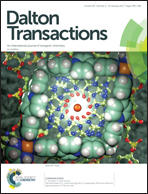Highly efficient electrochemiluminescence labels comprising iridium(iii) complexes†
Abstract
Improving the performance of labeling agents is crucial to the further development of electrochemiluminescence (ECL) related technologies. Although a large number of ECL luminophores beyond ruthenium complexes have been reported so far, there is still a scarcity of studies involving novel ECL labeling agents. Herein, five novel iridium ECL labels and one control label comprising a ruthenium complex have been rationally designed and thoroughly characterized using photophysical techniques, theoretical calculations and electrochemical characterization to assess the ECL properties in this work. Both in coreactant-assisted potential scan experiments and through an annihilation approach, most of these novel iridium labels exhibit equivalent or even-stronger ECL signals than tri-2,2′-bipyridylruthenium(II) [abbreviated as Ru(bpy)32+] under the same experimental conditions. Most importantly, using the same labeling protocol, bovine serum albumin (BSA) labeled with an iridium label (label 3 in this work) exhibits a much more intense ECL signal (1.9 times) than the same amount labeled with a traditional ruthenium complex (Ru-based Label in this work) in ProCell buffer solution. In addition to the advantage of exhibiting various emission colors, the novel iridium labels reported in this work may offer insight for the further development of ECL-based analytical technology.



 Please wait while we load your content...
Please wait while we load your content...